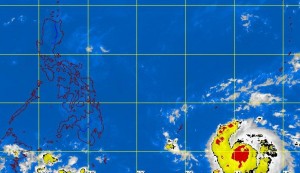MANILA, Philippines— The weather disturbance approaching the Philippines could become a supertyphoon, much stronger than last year’s Tropical Storm Sendong which ravaged the cities of Cagayan de Oro and Iligan, and is eerily moving in the same direction, Pagasa Administrator Nathaniel Servando said Saturday.
In terms of rainfall and wind strength, Typhoon Bopha has the potential for a bigger impact than Sendong, he said in a telephone interview. “This storm can be very destructive.”
“Unless it changes direction, this storm appears headed for the same areas in Northern Mindanao that Sendong hit,” he added.
Servando said Bopha, which would be locally named “Pablo” when it enters the Philippine area of responsibility (PAR), continued to gather strength as it swirled over the Pacific Ocean.
Already, it was packing maximum sustained winds of 165 kilometers per hour. “Considering that it’s still far from PAR, it can still grow much stronger,” he said. Sendong, a tropical storm, had sustained winds of only 100 kph but caused heavy loss of life as it dumped heavy rain on the watershed of Cagayan de Oro and Iligan cities, causing landslides and flashfloods in the middle of the night.
“By the time it arrives, it may have become as strong as that,” Servgando said when asked if the typhoon could reach wind strength of 210 kph, which US meteorologists would classify as a “superstorm.” Pagasa has no such category for tropical cyclones.
As of Saturday, however, Bopha was still a relatively small storm with a diameter of only 400-500 kilometers. By contrast, Sendong spanned about 600 kilometers, Servando said.
Servando said disaster officials were right to make early preparations for the storm, which was expected to make landfall either on the northeastern parts of Mindanao or northern Samar on Tuesday evening or early Wednesday.
He said Pablo could bring in the same devastation that characterized Sendong’s passage last year, including landslides and flash floods that washed away thousands of homes and killed more than 1,000 people across Northern Mindanao.
Sendong left more than 1,200 people dead and destroyed P1.3 billion in agriculture and property after dumping rains that spawned massive landslides and flash floods in Northern Mindanao on December 16 and 17.
Residents were left largely unprepared as storms and typhoons enter Mindanao much less frequently than they do Luzon and the Visayas.
In January, the Manila Observatory reported that in the past 15 years, only six typhoons crossed Mindanao, while an average of one typhoon a year made landfall in the region between 1883 and 1900.
Asked what the chances were of the storm veering from its projected path, Servando said: “Almost all our models show it moving in a west northwest direction. But there have been occasions in the past when the storm suddenly changed directions.”



